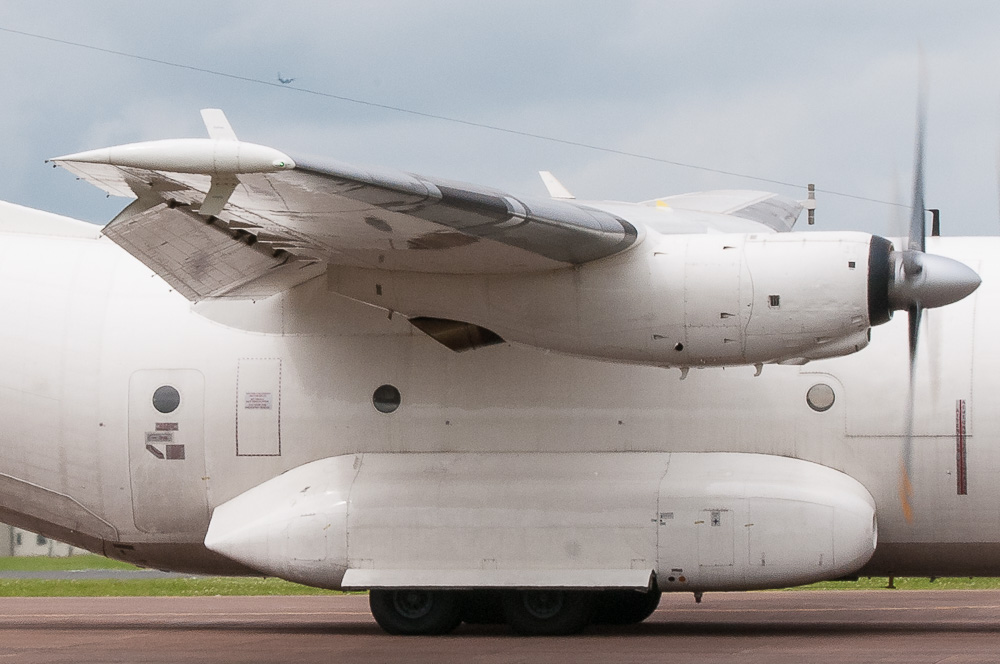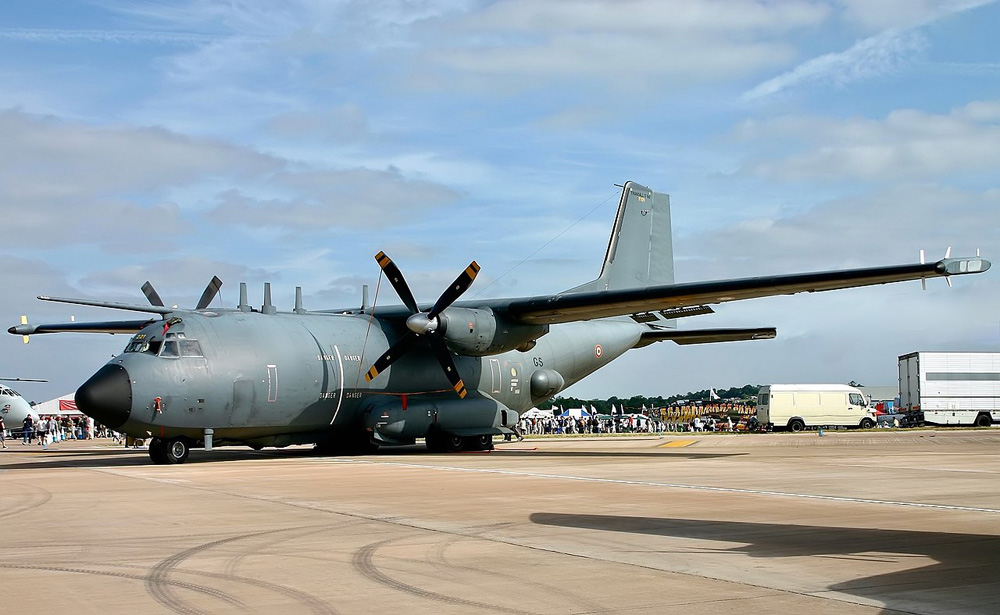
Transall C-160
When France and Germany needed a new military transport aircraft to replace the Noratlas they joined forces, or better the manufacturers MBB, Aerospatiale, and VFW-Fokker. They formed the Transporter Allianz consortium, or Transall in short.
The C-160 which they designed is a high wing aircraft about the size of a Lockheed Hercules. Like the C-130 the C-160 has a large wingspan, an upsloped rear fuselage with loading ramp and a conventional tail. The vertical stabiliser has a slightly tapered rectangular shape, and a large dorsal fin in front. Under the wings hang two turboprop engines. These have ring shaped intakes (around the prop spinner) and an exhaust at the back of the nacelle.
The main gear consists of two sets of double wheels on each side, retracting in pods at the side of the fuselage. The nose gear has two wheels. There aren't as many cockpit windows as on contemporary aircraft, but still seven all around, without eyebrow or feet windows.
The C-160 has two Tyne turboprop engines with ring shaped intakes. The main gear consists of two sets of double wheels, retracting in pods.
Like many military transport aircraft the rear fuselage of the Transall slopes up significantly. Above is a rectangular vertical stabiliser, slightly tapered towards the top.
Different versions
The different versions of the Transall C-160 can be distinguished by looking at:
- the presence of a refuelling boom op top of the cockpit
- the presence of a cargo door in the left forward fuselage
- the presence on many antennas on top of the fuselage and at the wingtips
- the presence of orange cones in the tailcone and below the rear loading ramp
C-160, C-160A, C-160D, C-160F & C-160Z
The prototypes (C-160), pre-production (C-160A) and German, French and South African production versions (C-160D, C-160F and C-160Z respectively) are externally the same, as are the conversions for the French postal services (C-160P). They all have a large cargo door in the left forward fuselage and no means for air-to-air-refuelling.
C-160G Gabriel
The electronic reconnaissance of the French air force, C-160G, is easily to distinguish because of the many antennas fitted to the aircraft, both on top of the fuselage and at wing tips. Like the C-160H, NG and R, the C-160G has a refuelling boom above the cockpit.
The C-160G is the electronic reconnaissance version of the French air force. As you can see it has many blade antennas on top of the fuselage, and different wingtips. (photo: Colin Cooke/WikiMedia)
C-160H Assarté
Used for relaying communications to and from French submarines, the C-160H Assarté version has long cable antennas that can be rolled out from the tail cone and below the rear loading ramp. When stowed, the orange conical ends are still visible. The C-160H also has a refuelling boom above the cockpit, like the C-160NG and C-160R.
Two orange cones extending from the tail cone and below the rear cargo door are the main reocgnition point of the C-160H.
C-160NG & C-160R
When the French military needed a second batch of aircraft, they chose an upgraded version, dubbed C-160NG (Nouvelle Generation, or New Generation). It has a refuelling boom above the cockpit as main recognition point. Additionaly, the large cargo door in the left forward fuselage was removed.
C-160R is the designation for a C-160F (so from the first production run) that has been converted with the same modifications as the C-160NG. Externally, they are the same.
Confusion possible with
Antonov An-8

The Soviet/Russian counterpart of the C‑160 is the Antonov An-8, the two engined version of the An‑12. It has different cockpit windows and a glass nose. Also the tail has a trapezium shape like on the C-130 and An-12. (photo: Felix Goetting/WikiMedia)
CASA C-295
The basic configuration and number of engines of the C-295 and C-160 are the same, but there are also many differences. The C-295 is smaller, has many cabin windows, a taller vertical stabiliser and two tandem main landing gear wheels, to name a few.
Lockheed C-130 Hercules
Comparable in size and appearance to the C-160 Hercules but obviously has four engines instead of two. Also has two big wheels on each main landing gear, in tandem configuration. Finally the tail has a trapezium shape and the cockpit many windows.
Antonov An-12 / Shaanxi Y-8
Both the An-12 and its Chinese copy are similar in size as the C-160, but have four engines. Also the tail is trapezoidal like on the C-130. The An-12 and Y-8 have four wheel bogeys on each leg and smaller pods for the gear.
Shaanxi Y-9

The Y-9 is a four engined plane like the Y-8 above (and clearly derived from that), but has a nose that is more similar to that of the C-160 than the An‑12/Y‑8. (photo: Alert5/WikiMedia)











